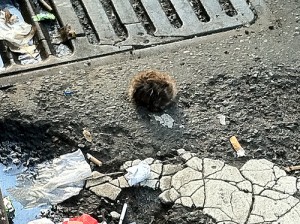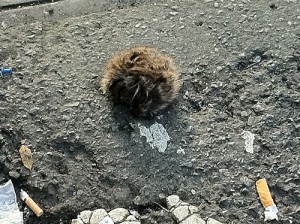I suppose there is a certain amount of cheek to me writing this on a leap day, a day that shouldn’t even exist except in service of an inaccurate calendrical system. Today exists, but then again it doesn’t, or rather it exists under the guise of a convenient idea. But what of materiality? The lost pom-poms I keep finding all over the streets of New York seem real enough, despite having been separated from their originally intended assemblages.
Things come and things go, but do we really understand this? At what point does matter coalesce into being and what are we left with when it disappears. Is nothing really nothing? A void? Emptiness? Or is nothing just something that hasn’t yet happened? What is the size and shape of this nothingness?
In The Turin Horse, The Hungarian filmmaker Béla Tarr envisions a world, inhabited by an elderly horse cart driver and his daughter, that is slowly diminishing over a series of days, as if the universe were a giant iris stopping itself down, until finally all we are left with is an overwhelming absence. But is this the absolute end? The filmmaker never answers this question. Perhaps the darkness he leaves us with is akin to the primordial dark matter, a kind of pre-generative firmament from which the rest of the universe will once again exude itself like so much quivering fruit.
The ongoing search for fundamental particles might indeed one day corroborate that there is, to quote Kurt Vonnegut – a “universal will to become” or ‘UWTB,’ as he puts it. Paradoxically, we appear to be only able to discern this by smashing things into smaller and smaller pieces using such pieces of über-technology as the Large Hadron Collider (LHC), through which it is hoped, the Higgs boson might one day emerge. The appearance of this much anticipated entity would be the closest thing yet to witnessing the actual origin of mass, erupting into existence when the Higgs field – the theoretical field that fills all of space – is excited above its ground state. The hitch is that the Higgs boson has been a little hard to find, though of late we seem to be getting tantalizingly close.
An appreciation for the tangled relationship between ‘nothingness’ and ‘somethingness’ is certainly not new, and the notion of ‘form is emptiness, emptiness is form,’ goes back to ancient times among Buddhists or as it is sometimes translated in the Heart Sutra: ‘Matter is empty, emptiness is matter.’
In her book Vibrant Matter, Jane Bennett calls for a new, vital materialism and a an acknowledgement of matter’s innate agency. Matter it would seem, should have rights and is worthy of our kindness and respect because at least on some level, it wills itself into being, forming its own aggregations and assemblages from, well, emptiness. Never truly inert, matter, by its very nature evokes a response and is thereby generative. In Japan, ceremonies are held at shrines for broken dolls or lost pins…
This generative nature is beautifully portrayed by the Polish writer Bruno Schulz in his (1934) short story – Tailor’s Dummies in which the narrator’s lucidly batty, geriatric father holds forth on the nature of matter in oracular torrents at the family dinner table:
“Matter (says the father) has been given infinite fertility, inexhaustible vitality and, at the same time, a seductive power of temptation, which invites us to create as well. In the depths of matter, indistinct smiles are shaped, tensions built up, attempts at form appear – the whole of matter pulsates with infinite possibilities that send dull shivers through it. Waiting for the life-giving breath of the spirit, it is endlessly in motion. It entices us with a thousand sweet, round shapes, which it blindly dreams up within itself.”
The son goes on to describe the spontaneous generation of pseudo life forms his has father dreamed up:
“a generato aequivoca, a species of beings only half organic, a kind of pseudofauna and pseudoflora, the result of fantastic fermentation of matter… These creatures – mobile, sensitive to stimuli and yet outside the pale of real life, cold be brought into being by suspending certain complex colloids in solutions of kitchen salt.”
Schulz goes on to imagine other generative phenomena such the floral wallpaper in abandoned rooms growing out into rampant, pseudo-botanical festoonery, then receding as soon as it is directly observed.
The pseudo-biological quality of inorganic matter is not just the domain of Eastern European fiction but is entirely observable. At the New York Institute for the Humanities’ recent Survival of the Beautiful event, British science writer Phillip Ball gave a fascinating account of how autocatalytic feedback and oscillating chemical reactions have been recently theorized to account for many natural patterns such as a zebra’s stripes or an angelfish’s swirls, the latter of which beautifully zip and unzip from each other as the fish grows with an aesthetic exuberance owing less to Darwinian natural selection than to the vibrant, self-assembling agency of matter itself. Called Belousov-Zhabotinsky reactions, these processes create biological looking patterns, quite independently of biology, which also appear in such inert substances as sand and mud.
The New Scientist recently featured a rather Schulzian sounding research project at University of Glasgow that is creating pseudo-life forms out of large metal molecules, called polyoxometalates, which when dissolved in certain salt solutions start to self-assemble into cell-like spheres, complete with pseudo membranes that have the ability to control the flow of chemicals to and from the ‘cell.’ Instead of using DNA, these polyoxometalate cells use each other as templates to self-replicate, but replicate they do and perhaps they will even evolve, though the experiment hasn’t been run long enough yet to bear that out.
Such self-amplifying processes bring to mind the presence of ‘morphic fields’ Rupert Sheldrake postulates might influence the way matter, both living and non-living, aggregates. Morphic fields, if indeed they exist, would act as a kind of organizing consciousness, increasing the likelihood that things assemble will themselves in certain ways – especially if a given configuration has already happened. The morphic field in some way ‘remembers’ arrangements it has encountered as a resonance – not unlike the excitation of the Higgs Field I described earlier – which in turn acts as a template for subsequent iterations.
So where does this leave us? Is anything every really empty or is what we perceive as emptiness just a transitional state between oscillations of form?
If what we think of as ‘agency’ turns out to be the pervasive action of fields, is there any point in making a distinction between what we have come to think of as ‘living’ and that which is not? It’s hard not to feel a little celebratory about all of this. Even if we can’t find any more so-called ‘life’ out there in the rest of the universe, the fact that we all are part of its vibrant assembly of matter should make us feel a little less lonely!





